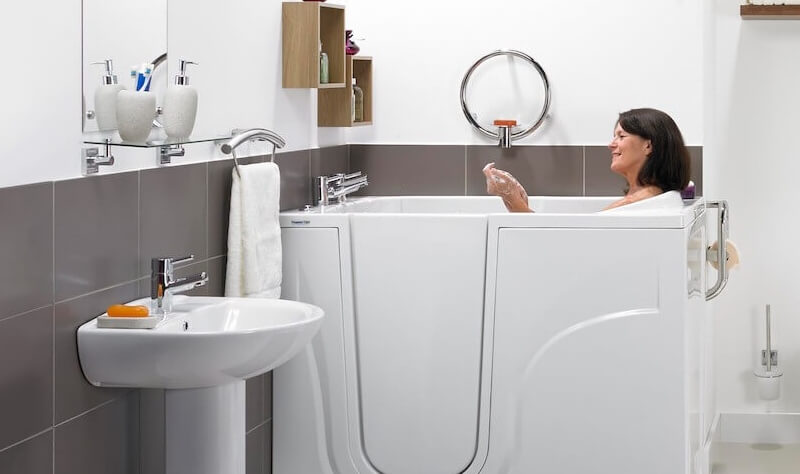How to tailor accessible bathrooms for both disabled and non-disabled use

If you have a carer then it will grant them easy access to the bathroom, whilst also promoting independent living. Installing a walk-in bath or walk-in shower is an accessible bathroom option to install in the home.
Making bathrooms accessible for those who have difficulty with their mobility day to day benefits the whole family. Additionally, it can make sure your bathroom is usable for years to come.
Want a safer bathroom?
Fill out the form in seconds and discover our full range of assisted bathing showers and baths.

- How to know if you need an accessible bathroom?
- Easy access for wheelchair users
- Think about the size of your bathroom
- Future proof your home
- Utilise a variety of light sources
- The most relaxing bathing experience for everyone
How to know if you need an accessible bathroom?
While it might seem like the answer to this question is obvious, accessible bathrooms can be needed for more than just the obvious mobility challenges attributed to the elderly or physically disabled. If your loved one suffers from a visual impairment, it might be worth investing in accessibility.
You could benefit from smaller features like tactile signs and Braille labels, as well as bigger adaptations to your bathroom. On the other hand, deaf family members (or those with hearing impairments) might benefit from visual alarms or notification devices.
Even family members with cognitive or neurological disabilities, such as dementia, may aid the struggles of daily activity with an accessible bathroom. Through simpler, more intuitive designs and clear signage to help them navigate the space safely, for example. The truth is that there are many reasons why you might need to modify your space for the sake of those you live with.
To find out whether it’s necessary in your case, consult your local government guidelines, or seek professional advice.
Easy access for wheelchair users
Adapting the home to suit your bathroom requirements may not be as tricky as you think. Low level access is a priority for wheelchair users and installing a wet room is the perfect solution, as well as placing comfort at the top of the list. It’s imperative to think about door access, and the ease of which to enter and exit the bathroom. Ideally, the door dimensions should have a minimum opening width of 800mm to accommodate the size of a wheelchair.
Think about the size of your bathroom
We would all love a spacious bathroom, but this isn’t always a reality for many. There are several ways to maximise your space to make it more accessible. Smart storage options are a great way to give you more space, whilst also neatly storing away any items in the bathroom.
Future proof your home
Thinking ahead when planning a new bathroom also enables its users to live independently for as long as possible. It’s also important to note that it doesn’t mean that design and style needs to be compromised. When designing the space make a note of where you’d like to install the accessible bathroom accessories, so you don’t have to make any drastic changes in the future.
Living in an ageing population, and not enough people to take a care of the elderly, it’s important more than ever to future proof the home. There are several ways to do this, for example installing grab bars is a great solution for extra security. If you have any spinal or back issues a powered reclining seat, would help support your back to position it in the bath correctly.
Utilise a variety of light sources
No doubt our eyesight gets worse as we age, and therefore it’s imperative to have enough light sources available in our bathroom, both natural and artificial. Having multiple sources of light is always helpful as capacity can be tailored to each user and time of the day. The better lit the space, the more likely falls and trips to be avoided.
The most relaxing bathing experience for everyone
Accessible bathtubs are a must for people with reduced mobility, and while its absolutely for the reason of their safety and comfort, there are plenty of ways it benefits non-disabled users. Chromotherapy (also called as colour therapy), for example, which can be installed in baths is a natural light treatment with a variety of soft colours that promotes relaxation and emotional well-being. Hydrovescent spa massage, another home-spa addition to the accessible bathtub is formed of champagne-like streams created by air jets around the sides and bottom of the bath – just like a home jacuzzi-, which helps improve circulation, relaxes muscles and relives inflammation in a gentle and non-intrusive way. Apart from aiding aches and pains, paired with a bubble bath, some candles and aroma therapy, it is a great way of easing stress - just like having your own spa at home!
Adapting the bathroom to your specific and tailored requirements will make your day to day life much easier in more ways than one. Everyone deserves the right to feel safe and secure in their home, by reducing the risk of any falls or incidents. Our dedicated team will ensure that you have a smooth installation process, providing you with A-class customer service. Give us a call or request a brochure here.

